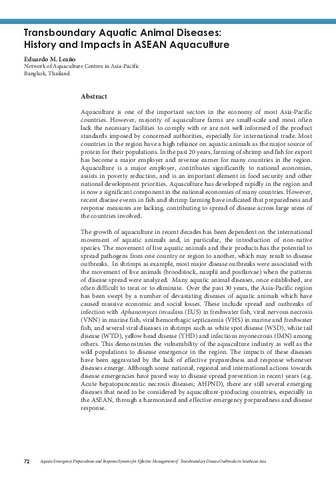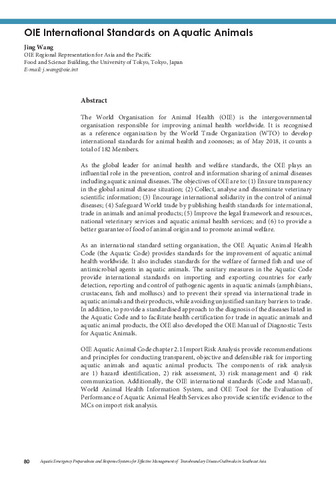Transboundary aquatic animal diseases: History and impacts in ASEAN aquaculture
| dc.contributor.author | Leaño, Eduardo M. | |
| dc.contributor.editor | Tendencia, Eleonor A. | |
| dc.contributor.editor | de la Peña, Leobert D. | |
| dc.contributor.editor | de la Cruz, Joesyl Marie V. | |
| dc.date.accessioned | 2019-07-23T08:09:32Z | |
| dc.date.available | 2019-07-23T08:09:32Z | |
| dc.date.issued | 2019 | |
| dc.identifier.citation | Leaño, E. M. (2019). Transboundary aquatic animal diseases: History and impacts in ASEAN aquaculture. In E. A. Tendencia, L. D. de la Peña, & J. M. V. de la Cruz (Eds.), Aquatic Emergency Preparedness and Response Systems for Effective Management of Transboundary Disease Outbreaks in Southeast Asia: Proceedings of Asean Regional Technical Consultation, 20-22 August 2018, Centara Grand Central Ladprao, Bangkok, Thailand (pp. 72-79). Tigbauan, Iloilo, Philippines: Aquaculture Department, Southeast Asian Fisheries Development Center. | en |
| dc.identifier.isbn | 9789719931089 | |
| dc.identifier.uri | http://hdl.handle.net/10862/3466 | |
| dc.description.abstract | Aquaculture is one of the important sectors in the economy of most Asia-Pacific countries. However, majority of aquaculture farms are small-scale and most often lack the necessary facilities to comply with or are not well informed of the product standards imposed by concerned authorities, especially for international trade. Most countries in the region have a high reliance on aquatic animals as the major source of protein for their populations. In the past 20 years, farming of shrimp and fish for export has become a major employer and revenue earner for many countries in the region. Aquaculture is a major employer, contributes significantly to national economies, assists in poverty reduction, and is an important element in food security and other national development priorities. Aquaculture has developed rapidly in the region and is now a significant component in the national economies of many countries. However, recent disease events in fish and shrimp farming have indicated that preparedness and response measures are lacking, contributing to spread of disease across large areas of the countries involved. The growth of aquaculture in recent decades has been dependent on the international movement of aquatic animals and, in particular, the introduction of non-native species. The movement of live aquatic animals and their products has the potential to spread pathogens from one country or region to another, which may result to disease outbreaks. In shrimps as example, most major disease outbreaks were associated with the movement of live animals (broodstock, nauplii and postlarvae) when the patterns of disease spread were analyzed. Many aquatic animal diseases, once established, are often difficult to treat or to eliminate. Over the past 30 years, the Asia-Pacific region has been swept by a number of devastating diseases of aquatic animals which have caused massive economic and social losses. These include spread and outbreaks of infection with Aphanomyces invadans (EUS) in freshwater fish, viral nervous necrosis (VNN) in marine fish, viral hemorrhagic septicaemia (VHS) in marine and freshwater fish, and several viral diseases in shrimps such as white spot disease (WSD), white tail disease (WTD), yellow head disease (YHD) and infectious myonecrosis (IMN) among others. This demonstrates the vulnerability of the aquaculture industry as well as the wild populations to disease emergence in the region. The impacts of these diseases have been aggravated by the lack of effective preparedness and response whenever diseases emerge. Although some national, regional and international actions towards disease emergencies have paved way to disease spread prevention in recent years (e.g. Acute hepatopancreatic necrosis diseases; AHPND), there are still several emerging diseases that need to be considered by aquaculture-producing countries, especially in the ASEAN, through a harmonized and effective emergency preparedness and disease response. | en |
| dc.language.iso | en | en |
| dc.publisher | Aquaculture Department, Southeast Asian Fisheries Development Center | en |
| dc.subject | South East Asia | en |
| dc.title | Transboundary aquatic animal diseases: History and impacts in ASEAN aquaculture | en |
| dc.type | Conference paper | en |
| dc.citation.spage | 72 | |
| dc.citation.epage | 79 | |
| dc.citation.conferenceTitle | Aquatic Emergency Preparedness and Response Systems for Effective Management of Transboundary Disease Outbreaks in Southeast Asia: Proceedings of Asean Regional Technical Consultation, 20-22 August 2018, Centara Grand Central Ladprao, Bangkok, Thailand | en |
| dc.subject.asfa | disease control | en |
| dc.subject.asfa | septicaemia | en |
| dc.subject.asfa | disease recognition | en |
| dc.subject.asfa | disease resistance | en |
| dc.subject.asfa | disease transmission | en |
| dc.subject.asfa | epidemiology | en |
| dc.subject.asfa | husbandry diseases | en |
| dc.subject.asfa | aquaculture regulations | en |
| dc.subject.asfa | quarantine regulations | en |
| dc.subject.asfa | fish culture | en |
| dc.subject.asfa | fish diseases | en |
| dc.subject.asfa | aquatic animals | en |
| dc.subject.asfa | aquaculture | en |
| dc.subject.asfa | aquaculture development | en |
| dc.subject.asfa | trade | en |
| dc.subject.asfa | fish | en |
| dc.subject.asfa | food security | en |
| dc.subject.asfa | marine fish | en |
| dc.subject.asfa | viral diseases | en |
| dc.subject.asfa | inland water environment | en |
| dc.subject.asfa | vulnerability | en |
| dc.subject.asfa | hepatopancreas | en |
| dc.subject.asfa | introduced species | en |
| dc.subject.asfa | necrosis | en |
| dc.subject.asfa | countries | en |
| dc.subject.asfa | shrimp culture | en |
| dc.subject.asfa | nauplii | en |
| dc.subject.asfa | marine crustaceans | en |
| dc.subject.asfa | economics | en |
| dc.subject.asfa | pathogens | en |
| dc.subject.asfa | animal diseases | en |
| dc.subject.asfa | breeding stock | en |
| dc.subject.asfa | fresh water | en |
| dc.subject.asfa | freshwater fishes | en |
| dc.subject.scientificName | Aphanomyces invadans | en |
Files in this item
รายการนี้ปรากฏใน (s)
-
Aquatic Emergency Preparedness and Response Systems for Effective Management of Transboundary Disease Outbreaks in Southeast Asia [20]
Proceedings of ASEAN Regional Technical Consultation, 20-22 August 2018, Centara Grand Central Ladprao, Bangkok, Thailand





